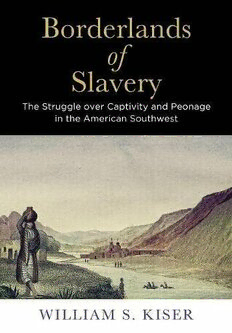
Borderlands of Slavery: The Struggle over Captivity and Peonage in the American Southwest PDF
Preview Borderlands of Slavery: The Struggle over Captivity and Peonage in the American Southwest
Borderlands of Slavery AMERICA IN THE NINETEENTH CENTURY Serieseditors BrianDeLay,StevenHahn,AmyDruStanley AmericaintheNineteenthCenturyproposesarigorous rethinkingofthismostformativeperiodinU.S.history. Booksintheserieswillbewide-rangingandeclectic,with aninterestinpoliticsatalllevels,cultureandcapitalism, raceandslavery,law,gender,andtheenvironment,and regionalandtransnationalhistory.Theseriesaimstoexpand thescopeofnineteenth-centuryhistoriographybybringing classicquestionsintodialoguewithinnovativeperspectives, approaches,andmethodologies. BOR DER LANDS of SLAVERY THE STRUGGLE OVER CAPTIVITY AND PEONAGE IN THE AMERICAN SOUTHWEST WILLIAM S. KISER university of pennsylvania press philadelphia Copyright(cid:2)2017UniversityofPennsylvaniaPress Allrightsreserved. Exceptforbriefquotationsusedforpurposesofrevieworscholarlycitation, noneofthisbookmaybereproducedinanyformbyanymeans withoutwrittenpermissionfromthepublisher. Publishedby UniversityofPennsylvaniaPress Philadelphia,Pennsylvania19104-4112 www.upenn.edu/pennpress PrintedintheUnitedStatesofAmerica onacid-freepaper 1 3 5 7 9 10 8 6 4 2 ACataloging-in-PublicationrecordisavailablefromtheLibraryofCongress ISBN978-0-8122-4903-3 ForNicole,theloveofmylife This page intentionally left blank Contents Prologue 1 Introduction 15 Chapter1.DebatingSouthwesternSlaveryintheHallsofCongress 23 Chapter2.IndianSlaveryMeetsAmericanSovereignty 57 Chapter3.ThePeculiarInstitutionofDebtPeonage 88 Chapter4.SlaveCodesandSectionalFavor 112 Chapter5.ReconstructionandtheUnravelingofAlternativeSlaveries 142 Conclusion 170 Notes 181 Bibliography 235 Index 257 Acknowledgments 265 This page intentionally left blank Prologue In a January 1864 communication with Indian Commissioner William P. Dole,NewMexicoSuperintendentofIndianAffairsMichaelSteckprovided a concise description of Indian slavery that alluded to every fundamental aspect of the practice as it existed in the Southwest. Upon being taken intocaptivity,heexplained,indigenousslaves“areusuallyadoptedintothe family,baptized,andbroughtupintheCatholicfaith,andgiventhename of the owner’s family, generally become faithful and trustworthy servants, andsometimesaremarriedtothenativeNewMexicans.”1Inasinglebreath the superintendent summarized—albeit somewhat superficially—Indian slavery as it existed not only in American times but in earlier Spanish and Mexican periods as well. Steck’s previous decade of experience with New MexicoIndian affairs renderedhimeminentlyqualified tocommentupon the nature of captivity. His letter to Dole asserted the widespread cultural hybridity and concomitant transformation of human identity that ema- natedfromcaptivityanddependency,practicesthatpredatedSteck’sarrival inNewMexicobythreecenturies. Humancaptivitywasacriticalcomponentofindigenouswarfare,labor, and socialinteraction in theSouthwest long before the influxof European explorers andcoloniststhat beganinthe sixteenthcentury.Complextrade networks linked nomadic peoples of the Plains with sedentary Puebloan inhabitants of the upper Rio Grande region through intricate commercial mechanisms, primarily involving commodities obtained through hunting, gathering,and cultivation.Theexchange ofhumansubjects, however,also formed an element of this culturally entrenched kin-based system, with adoption, dependency, and assimilation being important components. IntertribalwarfareintheSouthwestperpetuatedacontinuingcaptivetrade, onebasedmoreonhonor,community,genderroles,andkinshipdemands ratherthanoneconomicnecessity.2WhenFranciscoVasquezdeCoronado reached northern New Mexico in 1540–41, he found a thoroughly enmeshed system of slavery emanating from warfare and raiding between
